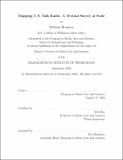| dc.contributor.advisor | Deb Roy. | en_US |
| dc.contributor.author | Brannon, William(William Walker) | en_US |
| dc.contributor.other | Program in Media Arts and Sciences (Massachusetts Institute of Technology) | en_US |
| dc.date.accessioned | 2021-01-06T20:15:37Z | |
| dc.date.available | 2021-01-06T20:15:37Z | |
| dc.date.copyright | 2020 | en_US |
| dc.date.issued | 2020 | en_US |
| dc.identifier.uri | https://hdl.handle.net/1721.1/129270 | |
| dc.description | Thesis: S.M., Massachusetts Institute of Technology, School of Architecture and Planning, Program in Media Arts and Sciences, September, 2020 | en_US |
| dc.description | Cataloged from student-submitted PDF version of thesis. | en_US |
| dc.description | Includes bibliographical references (pages 130-140). | en_US |
| dc.description.abstract | This thesis attempts the first large-scale mapping of American talk radio, leveraging recently developed datasets of transcribed radio programs. We set out to explore the internal structure of this influential medium along three axes, reflecting a typology of the main social contexts in which it is embedded: its corporate ownership, its geographical location in the country and perhaps most importantly its relationship to the broader media ecosystem, operationalized through Twitter. The results depict a radio ecosystem operating in a mostly centralized way. In talk radio, station ownership, usually by large publicly traded companies, is the strongest correlate of cosine similarity in the stations' distributions of airtime to shows; in public radio, the greater similarity of these airtime distributions medium-wide than in talk radio reflects the influence of centralized, nationwide syndication networks like NPR. | en_US |
| dc.description.abstract | The distribution of important topics of political discussion is also surprisingly similar across stations. Geography plays relatively little role, with programming and topics varying little along geographic lines. Despite these centralizing tendencies, local radio is not extinct even on large corporate stations, and is meaningfully local in content as well as production. Local programs have lower average cosine similarities between their topic mixtures than syndicated ones do, demonstrating a greater diversity of discussion topics and perhaps perspectives. These shows are also more in touch with local opinion, in that models trained on their text better predict the partisan lean of their listeners than is true of syndicated radio. But syndication makes up the large majority of stations' airtime. Moving to the third of our three axes, radio reflects the same underlying social structure as Twitter, and this structure is reflected in the content of broadcasts. | en_US |
| dc.description.abstract | We examined the relationship by comparing radio to a set of highly followed and influential journalists and politicians. The influential Twitter users manifest a similar social structure to radio: graph communities and a measure of latent ideology extracted from the follow graph fit radio's offline structure well; more directly, the follow graph itself and the "co-airing graph" (between shows, in which two shows are connected if they air on the same station) are quite similar. Moreover, this common social structure is predictable from the text of radio shows. The contents of Twitter and radio are also closely linked, with hosts discussing a similar mix of topics on both platforms. A case study of President Trump's tweets reveals their probable causal effects on radio discussion, though other evidence of direct influence from Twitter is much more limited. | en_US |
| dc.description.abstract | The American talk radio ecosystem, as revealed here, while still partly local in character, is an integral part of the national media ecosystem and best understood in that context. | en_US |
| dc.description.statementofresponsibility | by William Brannon. | en_US |
| dc.format.extent | 140 pages | en_US |
| dc.language.iso | eng | en_US |
| dc.publisher | Massachusetts Institute of Technology | en_US |
| dc.rights | MIT theses may be protected by copyright. Please reuse MIT thesis content according to the MIT Libraries Permissions Policy, which is available through the URL provided. | en_US |
| dc.rights.uri | http://dspace.mit.edu/handle/1721.1/7582 | en_US |
| dc.subject | Program in Media Arts and Sciences | en_US |
| dc.title | Mapping U.S. talk radio : a textual survey at scale | en_US |
| dc.title.alternative | Mapping United States talk radio | en_US |
| dc.type | Thesis | en_US |
| dc.description.degree | S.M. | en_US |
| dc.contributor.department | Program in Media Arts and Sciences (Massachusetts Institute of Technology) | en_US |
| dc.identifier.oclc | 1227784631 | en_US |
| dc.description.collection | S.M. Massachusetts Institute of Technology, School of Architecture and Planning, Program in Media Arts and Sciences | en_US |
| dspace.imported | 2021-01-06T20:15:36Z | en_US |
| mit.thesis.degree | Master | en_US |
| mit.thesis.department | Media | en_US |
